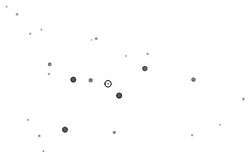Upsilon2 Cassiopeiae
| Observation data Epoch J2000.0 Equinox J2000.0 | |
|---|---|
| Constellation | Cassiopeia |
| Right ascension | 00h 56m 39.905s[1] |
| Declination | +59° 10′ 51.80″[1] |
| Apparent magnitude (V) | +4.62[2] |
| Characteristics | |
| Spectral type | G8 IIIb Fe-0.5[3] |
| U−B color index | +0.68[2] |
| B−V color index | +0.96[2] |
| Variable type | none |
| Astrometry | |
| Radial velocity (Rv) | −47.73±0.12[4] km/s |
| Proper motion (μ) | RA: −92.65±0.18[1] mas/yr Dec.: −45.50±0.16[1] mas/yr |
| Parallax (π) | 16.32 ± 0.23[1] mas |
| Distance | 200 ± 3 ly (61.3 ± 0.9 pc) |
| Absolute magnitude (MV) | +0.62[5] |
| Details[4] | |
| Mass | 1.44±0.16 M☉ |
| Radius | 10.37±0.26 R☉ |
| Luminosity | 67.6 L☉ |
| Surface gravity (log g) | 2.75±0.19 cgs |
| Temperature | 4,937±14 K |
| Metallicity [Fe/H] | −0.35±0.03 dex |
| Rotational velocity (v sin i) | 0.54±0.38 km/s |
| Age | 2.20±0.62 Gyr |
| Other designations | |
| Database references | |
| SIMBAD | data |
Upsilon² Cassiopeiae (υ² Cassiopeiae, abbreviated Ups² Cas, υ² Cas), also named Castula,[6] is a solitary star in the constellation of Cassiopeia. It is a yellow G-type giant with an apparent magnitude of +4.62 and is approximately 200 light-years from the Sun.[1] This is a barium star, which may indicate it has an orbiting white dwarf companion.[5]
Nomenclature
υ² Cassiopeiae (Latinised to Upsilon² Cassiopeiae) is the star's Bayer designation. In 2016, the IAU organized a Working Group on Star Names (WGSN)[7] to catalog and standardize proper names for stars. The WGSN approved the name Castula for this star on 5 September 2017 and it is now so included in the List of IAU-approved Star Names.[6]
References
- 1 2 3 4 5 6 van Leeuwen, F. (2007). "Validation of the new Hipparcos reduction". Astronomy and Astrophysics. 474 (2): 653–664. arXiv:0708.1752. Bibcode:2007A&A...474..653V. doi:10.1051/0004-6361:20078357. Vizier catalog entry
- 1 2 3 Argue, A. N. (1966), "UBV photometry of 550 F, G and K type stars", Monthly Notices of the Royal Astronomical Society, 133: 475, Bibcode:1966MNRAS.133..475A, doi:10.1093/mnras/133.4.475.
- ↑ Keenan, Philip C.; McNeil, Raymond C. (1989), "The Perkins catalog of revised MK types for the cooler stars", Astrophysical Journal Supplement Series, 71: 245, Bibcode:1989ApJS...71..245K, doi:10.1086/191373.
- 1 2 Jofré, E.; et al. (2015), "Stellar parameters and chemical abundances of 223 evolved stars with and without planets", Astronomy & Astrophysics, 574: A50, arXiv:1410.6422, Bibcode:2015A&A...574A..50J, doi:10.1051/0004-6361/201424474.
- 1 2 Bergeat, J.; Knapik, A. (May 1997), "The barium stars in the Hertzsprung-Russel diagram.", Astronomy and Astrophysics, 321: L9, Bibcode:1997A&A...321L...9B.
- 1 2 "Naming Stars". IAU.org. Retrieved 16 December 2017.
- ↑ "IAU Working Group on Star Names (WGSN)". Retrieved 22 May 2016.
This article is issued from
Wikipedia.
The text is licensed under Creative Commons - Attribution - Sharealike.
Additional terms may apply for the media files.
